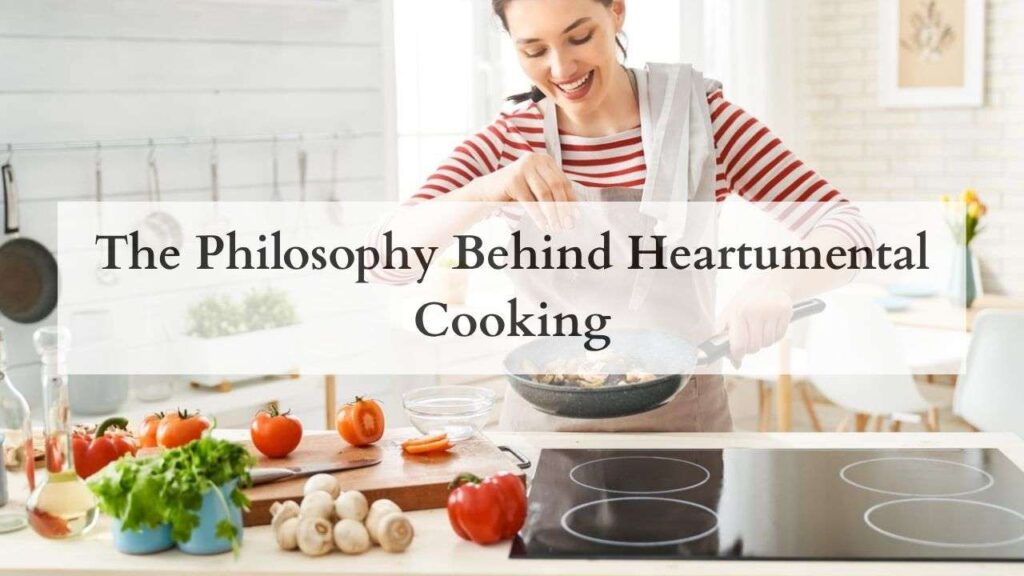When you’re stressed about what to cook or feeling guilty about ordering takeout AGAIN, this cooking guide heartumental steps in as your kitchen buddy.
Now, you may wonder what that is, let me tell you.
It’s this really cool way of thinking about food that puts your heart (literally and emotionally) at the center of your kitchen habits.
We get that cooking at home is HARD, especially when you’ve to balance between work and family stuff.
I was the same but after discovering this cooking guide by heartumental, I realised there’s surely a way to have healthy food.
In this post, I’m going to walk you through the whole cooking guide by Heartumental approach.
We’ll talk about where this cooking style came from, dive into the actual techniques that make it work, and look at how to fit it into your real life.
Ready to change how you think about cooking? Let’s go!
The Philosophy Behind Heartumental Cooking

The people who created the Heartumental approach totally get what modern life is like.
They know you’re struggling a million things and that complicated recipes with weird ingredients just aren’t happening most days.
You know how some days cooking feels like this awful chore you HAVE to do?
The Heartumental philosophy focuses on bringing the actual joy back to your kitchen by connecting with your food in a way that feels good.
When you cook with intention and awareness, something magical happens – you start to actually like being in the kitchen again!
The whole approach is built around this idea that mindful cooking and eating habits aren’t just good for your physical heart (though they definitely are), but they’re also good for your emotional well-being.
Cooking Guide Heartumental: Techniques & Methods
Let me break down the actual methods that make this approach work.
These aren’t complicated chef skills – they’re simple habits that anyone can easily pick up.
Let’s begin with our exploration of different techniques and methods that you’ll find in cooking guide Heartmental.
Do Mindful preparation
Mindful prep is just about slowing down enough to notice what you’re doing.
Feel the cool water as you wash veggies, notice the colors and smells.
When I first tried this, it felt weird. Then I realized cooking had become this thing I rushed through while half-watching YouTube.
Now I use chopping veggies as my little zen moment in the day.
You’d be shocked how much more you enjoy the meal when you’re present while making it.
Try Different Cooking Methods
You don’t need to deep-fry everything.
You can try – Grilling, roasting, and steaming, they create AMAZING flavors without drowning food in oil.
Roasting veggies brings out natural sweetness.
Grilling adds that smoky taste without extra calories.
I was stuck in this pan-fry rut until I discovered how crispy veggies get when roasted at high heat with just a tiny bit of oil.
Now my go-to weeknight dinner is a sheet pan of roasted veggies, some quinoa, and a quick grilled protein. So simple but tastes fancy!
Balance Flavor and Health
Nobody wants to eat bland health food and Heartumental approach uses herbs, spices, citrus, and vinegars to create big flavors without relying on tons of salt, sugar, or processed stuff.
Try this quick trick: before reaching for salt, add lemon juice or vinegar to your dish.
The acidity brightens flavors instantly.
Stock your pantry with smoked paprika, cumin, dried herbs, and red pepper flakes.
These zero-calorie flavor bombs transform basic ingredients into meals you’ll actually crave.
Build a Balanced Plate
This is such a game-changer! Instead of stressing about every little ingredient, focus on the overall balance of your plate.
Aim for half veggies, quarter whole grains, quarter lean protein.
This simple formula takes the guesswork out of eating healthy.
I keep a bag of frozen veggies for busy nights so I can always hit that half-plate goal.
When eating out, I mentally divide my plate the same way, often taking home the extra carbs for another meal.
Do Smart Ingredient Swaps
Small tweaks can make traditional recipes way healthier without sacrificing the comfort factor.
Use olive oil instead of butter, Greek yogurt instead of sour cream, or whole grain pasta instead of white.
I was skeptical about cauliflower rice until I properly seasoned it and paired it with a flavorful curry.
Now I barely notice the difference!
Start with one swap per recipe rather than changing everything at once, so your taste buds can adjust gradually.
Food Presentation
We eat with our eyes first!
Taking an extra 30 seconds to arrange food nicely actually makes it taste better.
Use colorful veggies, fresh herbs as garnish, or serve in a nice bowl instead of eating from the pot.
When I started plating my home meals like I cared (even just for myself!)I noticed I ate more slowly and felt more satisfied.
Here’s a bonus tip: Food that looks pretty is more fun to share on your stories, but only if you’re into that kind of thing. But food that looks good and tastes good is surely a plus point too.
Things to Consider While Adapting Cooking Guide Heartumental
There are a few things that you need to consider when you start adapting this cooking guide heartmental. Here are some practical tips:
- Batch prep basics on weekends – roast a big tray of veggies, cook a pot of grains, and prep a protein to mix and match all week
- Keep flexible recipes on hand – learn formats like “grain bowls” or “stir fries” that work with whatever ingredients you have
- Start small – add one Heartumental habit at a time instead of overhauling everything at once
- Stock smart staples – brown rice, quinoa, canned beans, frozen veggies, and a few spice blends can save any meal
- Combine shortcuts with fresh elements – use pre-chopped veggies or rotisserie chicken paired with something fresh
- Create simple rituals – maybe it’s making a nice cup of tea before cooking or playing your favorite music
- Go easy on yourself – this isn’t about perfection, it’s about gradually building habits that feel good
The beauty of this approach is how flexible it is.
You don’t need special equipment or hours of free time.
Just a few minutes of intention can transform your everyday meals.
How does this Cooking Guide Heartumental help?
The Heartumental approach doesn’t stop when the cooking ends – it flows right into how you actually eat the food.
When you cook mindfully, you’re more likely to eat mindfully too.
That means actually sitting down at a table, noticing the flavors, chewing slowly, and putting your phone away.
My friend started doing this and said it was weird how much more satisfied she felt after meals.
She wasn’t snacking all evening because she actually registered that she’d eaten dinner!
Plus, meals became this little reset button in her day instead of just fuel she shoved in while working.
Beyond just the eating experience, this approach has some pretty sweet benefits:
- Your grocery bills might shrink when you focus on simple, whole foods
- Your energy levels even out when you’re eating balanced meals
- Cooking becomes this stress-relief thing instead of another source of pressure
- You might find yourself naturally craving healthier foods
- Sharing these kinds of meals brings people together in a really nice way
- Your kitchen stops being this place of chaos and becomes somewhere you actually want to be
I noticed that once I started cooking with more intention, I wastef way less food.
I’d actually use what I bought because I was thinking about my ingredients differently.
My wallet definitely appreciated that unexpected bonus!
Conclusion
The cooking guide heartumental approach isn’t just another complicated diet or meal plan – it’s a completely different way to think about your relationship with food.
It brings together what’s good for your physical heart with what nourishes your emotional well-being.
We covered a lot here!
The mindful preparation that changes your cooking experience, those simple technique shifts that make healthy food taste amazing, practical ways to balance your plate, and how to actually fit all this into your real life.
Even small changes to how you approach cooking can ripple out into better eating habits, more enjoyment of your food, and maybe even lower stress levels.
What I love most about this whole approach is that it makes cooking feel doable again.
So, put on music you love, take a deep breath before you start chopping, or try a new herb in a familiar dish.
Your Heartumental cooking journey starts with just a single mindful moment in the kitchen.

